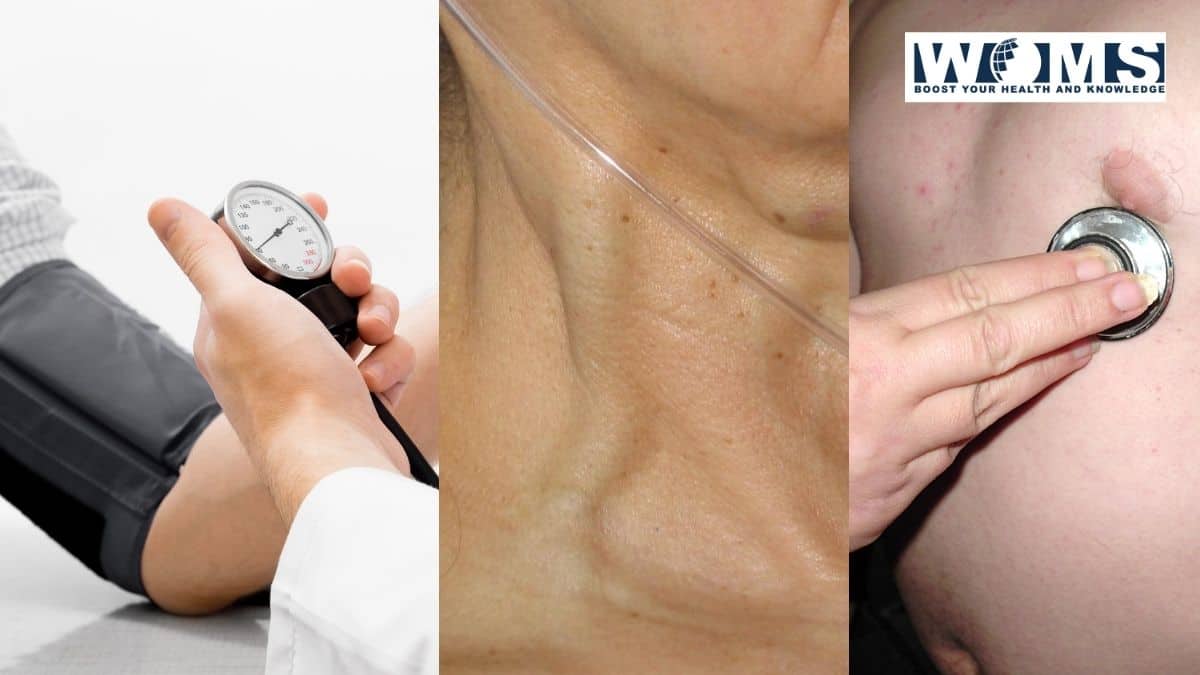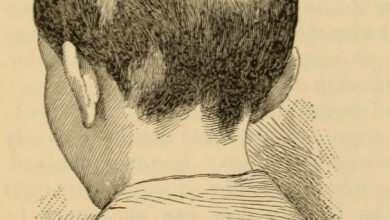Becks Triad

Becks triad is a medical triad that is a group of three signs and symptoms. A medical triad hints towards a specific medical condition.
Beck’s triad is a collection of signs and symptoms that give doctors a clue that a patient might be suffering from cardiac tamponade. It is also called the cardiac tamponade triad. The three classical signs include:
- Decrease in systolic blood pressure (narrowed pulse pressure)
- Reduced or muffled heart sounds on auscultation
- Distended neck veins
These three clinical signs associated with Becks triad are generally present in only a few percentages of patients. Not all patients suffering from cardiac tamponade present with all three clinical signs. Additional symptoms also show such as shortness of breath and tachycardia.

Why is it called Becks triad?
An American cardiac surgeon called Claude Beck first discovered these three clinical signs associated with cardiac tamponade and named them after his name, Becks triad.
What is Cardiac Tamponade?
A double-walled sac surrounds and protects the heart that is called the pericardial sac. A small amount of fluid (usually 25-50 ml) fills the pericardial sac which prevents friction between the two layers of the pericardium. The fluid helps the heart to expand and contract smoothly, minimizing the friction between the two layers of the pericardium.
Cardiac tamponade is a condition in which the pericardial sac becomes filled with blood or air, called pericardial effusion. This can occur due to a variety of reasons such as rupture of the aorta, intra-pericardial hemorrhage, or chest trauma. The accumulation of blood or air in the pericardial sac prevents the heart from expanding properly. In this way, the heart is unable to pump blood effectively and supply blood to the body. We can diagnose cardiac tamponade by the three classical signs of Beck’s triad.
How is Beck’s triad associated with neck vein distention?
The blood starts to pool backward due to decreased pumping activity of the heart. External compression by the fluid accumulated in the pericardial sac results in reduced pumping ability of the heart. This causes increased venous pressure and venous distention.
It is most prominent in the veins draining the heart such as the jugular veins. This results in jugular vein distention (JVD) in the cardiac tamponade patient even in the upright position. But in case of severe hypovolemia, the neck veins do not distend.
Jugular venous distention
Jugular veins are present on both sides of the neck. These veins distend when the pressure in the superior vena cava increases due to sluggish blood flow. The jugular veins bulge and become visible on the right side of the neck.
Jugular venous distention can occur in a variety of conditions such as cardiac tamponade, pulmonary hypertension, tricuspid valve stenosis, obstruction in the superior vena cava, and constrictive pericarditis.
Loss of rapid y descent in cardiac tamponade
The rapid y descent indicates the flow of blood from the right atrium to the right ventricle after opening of the tricuspid valve.
The y descent is absent in cardiac tamponade because blood flow from the right atrium to the right ventricle is slowed or impaired due to the application of the compressing force of the fluid or blood present in the pericardial sac. This results in narrowed pulse pressure, a symptom of Becks triad.
Mnemonics for becks triad

3Ds
- D= Distant heart sound
- D= Distended jugular veins
- D= Decrease arterial blood pressure
How is a decrease in blood pressure associated with Beck’s triad?
The heart does not pump effectively due to fluid accumulation in the pericardial sac. This is because the ventricles of the heart cannot expand properly due to the external force applied by the fluid in the pericardial sac. It decreases the end-diastolic volume and thus, decreases stroke volume. Decreased stroke volume results in a large decrease in systolic blood pressure.
According to Frank-Starlings’ law
This is in accordance with the Frank-Starlings’ law. According to this law, a decrease in end-diastolic volume (EDV) results in weak stroke volume which in turn results in decreased systolic blood pressure.
Narrowing of pulse pressure is seen due to a large decrease in systolic blood pressure.
How is Beck’s triad associated with muffled heart sounds?
The layer of fluid present in the pericardial sac dampens the cardiac sounds upon auscultation. The fluid or blood layer between the heart and the stethoscope acts as an insulating layer. So the heart sounds get muffled or cannot be heard or appreciated.
What other symptoms can be associated with Becks triad?
Patients of cardiac tamponade can also present with atypical symptoms other than the classical signs of Beck’s triad. These symptoms include increased heart rate or tachycardia, shortness of breath, increased respiratory rate, and coughing. Patients may also experience:
- Anxiety
- Restlessness
- Lightheadedness due to decreased blood supply to the brain
- Cold, clammy skin
- Bluish skin
- Fainting
- Chest pain
Pulsusparadoxus
Another symptom called pulsus paradoxus can be seen. A large decrease in systolic blood pressure during inspiration is a characteristic finding, usually of more than 10 mmHg. Pulsus paradoxus is more important in patients with slowing developing cardiac tamponade because these patients may not present with the other clinical signs of Becks triad.
How to measure pulsusparadoxus
We can measure it by a blood pressure apparatus. Take the first reading when the beats are heard during expiration but vanish during inspiration. Now, record the second reading when beats are audible both during inspiration and expiration.
How to diagnose the symptoms of Beck’s triad?
Doctors will diagnose the three classical symptoms of Becks triad can be diagnose in the following ways:
Echocardiogram
An echocardiogram is an ultrasound of the heart that allows one to see if the pericardial sac is distended. The compressed ventricle will also show in the case of cardiac tamponade.
Chest X-ray
Chest X-ray can also indicate that whether the cardiac tamponade is present or not. The heart will show as a globe-shaped organ.
Electrocardiogram (ECG)
An electrocardiogram of the heart will help assess the heartbeat to check for narrowed pulse pressure or pulsus paradoxus.
Auscultation of heart sounds
Heart auscultation with the help of a stethoscope will indicate the presence of muffled heart sounds.
CT Scan of the heart
CT scan of the heart will provide an entire image of the heart that can confirm the presence of fluid in case of cardiac tamponade.
Magnetic Resonance Angiogram (MRA)
An MRA can provide information of any abnormality in the blood flow along the blood vessels.
Beck’s triad vs. Cushing’s triad
Cushing’s triad is another set of clinical symptoms that show up due to an acute increase in intracranial pressure. The symptoms include widened pulse pressure (rather than narrowed pulse pressure in Becks triad), irregular respiration (bradypnea), and bradycardia.
Frequently asked questions
What do the classical signs of Beck’s triad indicate?
The classical signs of Beck’s triad indicate that the patient might be suffering from cardiac tamponade which is the accumulation of blood or air in the pericardial sac. It is a serious condition and needs immediate attention.
How are the symptoms of Beck’s triad treated?
The following procedures will help treat the symptoms of Beck’s triad or cardiac tamponade triad:
1. Pericardiocentesis (Doctors drain the fluid in the pericardium with the help of a needle)
2. Thoracotomy (Removal of blood from around the heart)
3. Pericardiectomy (Removal of a part of pericardium surgically to relieve pressure)
What is meant by muffled heart sounds?
A barrier is present between the heart and the stethoscope dampen the heart sounds resulting in muffled heart sounds. Muffled heart sounds are a clinical feature of Beck’s triad. The pericardial fluid accumulates in cardiac tamponade and acts as an insulating layer that dampens the heart sounds.
Is cardiac tamponade a life-threatening condition?
Yes, cardiac tamponade can be a life-threatening condition if left untreated. It is the slow accumulation of fluid, blood, or air in the pericardial sac which limits the ability of the heart to pump blood effectively. The clinical signs associated with Beck’s triad help to diagnose cardiac tamponade and it requires immediate medical attention.
What causes the accumulation of fluid in the pericardial sac?
The accumulation of fluid in the pericardial sac can be a result of:
1. Aortic rupture
2. intrapericardial hemorrhage
3. Chest trauma
4. Infective pericarditis
5. Malignancy
Do the symptoms of Beck’s triad develop all of a sudden?
The development of symptoms depends on the condition of the disease. In case of slow accumulation of fluid in the pericardial sac, the symptoms appear slowly and usually all three symptoms do not show up in one patient. Whereas in the case of rapid accumulation of fluid, the symptoms of Beck’s triad show rapidly.




